IN TODAY'S ISSUE:
- We look at various market metrics to determine if the current rally is overheated or if it can continue.
- As the July 4th Whale exits his position, we look at timing and potential market impact.
- We take an updated look at crypto legislation and regulation and the House advances 3 bills during “Crypto Week.”
Market Signals Have Yet to Show Signs of Froth
As bitcoin again soared to new levels this week, we look at what market data says about trader positioning. Our conclusion after looking at perpetual swap (perp) funding rates, CME-listed futures basis, hedge fund trading of CME futures, and stablecoin borrow rates is that traders are far from over their skis in terms of market exuberance. Most statistics are well below last cycle highs or even recent peaks.
Offshore Perpetual Funding Rates
Perpetual swaps (futures) on offshore exchanges are among the most popular instruments for traders seeking leveraged exposure. These contracts, which can be collateralized with either the underlying asset or stablecoins, offer leverage of up to 100×, depending on the specific asset and platform.
One key feature of perps is the funding rate, a periodic payment between long and short positions. When the funding rate is positive, traders holding long positions pay interest to those holding shorts on the opposite side of the trade, typically every eight hours.
As the chart below illustrates, funding rates can spike dramatically when demand to go long intensifies. While the current annualized rate of 12.3% is elevated, it's still well below the triple-digit levels seen during periods of extreme bullish speculation. Why are traders willing to pay such high borrowing costs? Because these trades are usually short-term, with funding fees charged every 8 hours. Traders don’t intend to maintain these positions for a full year—they’re looking to profit from short-term price movements.
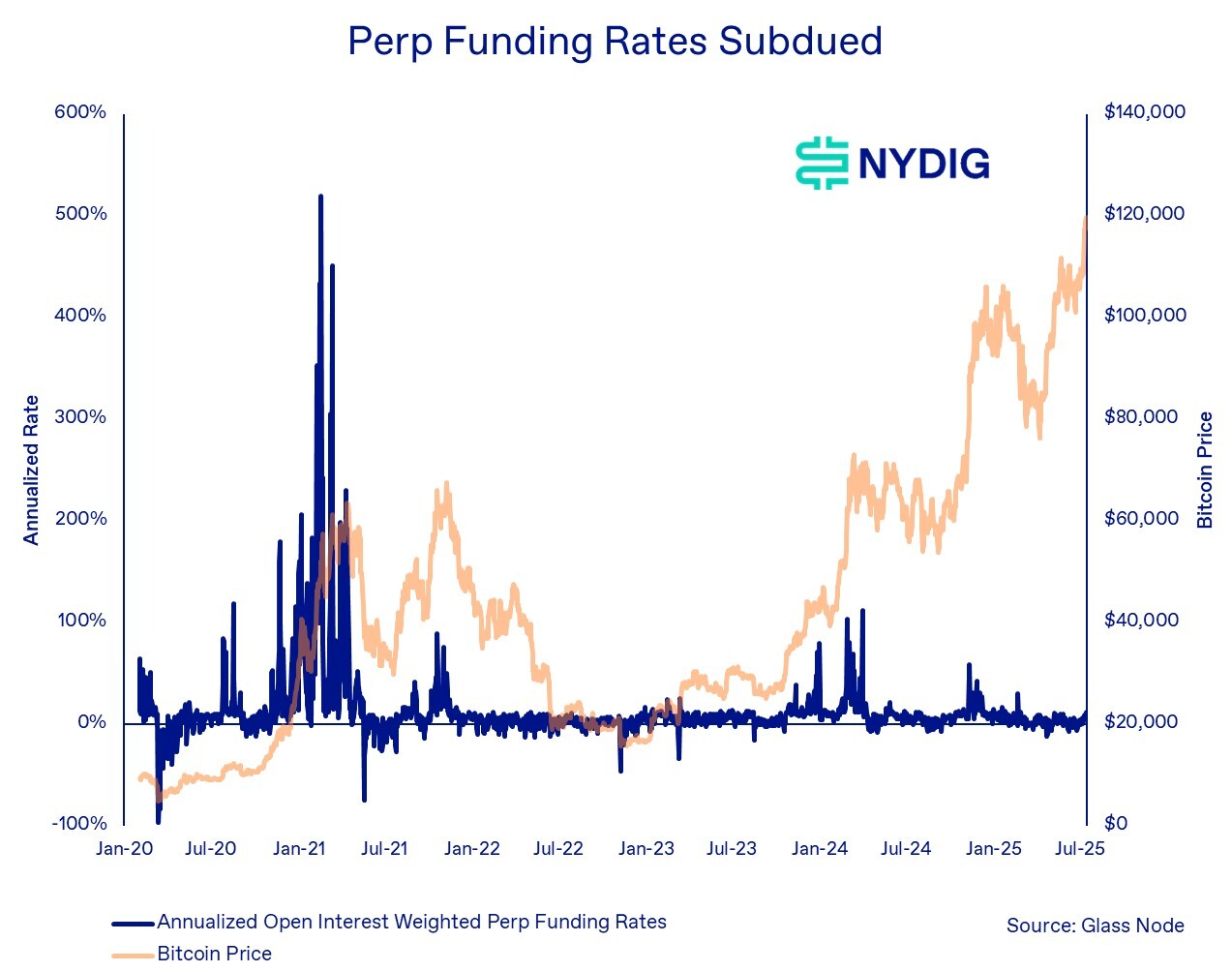
Onshore Regulated Futures Basis
For U.S.-based traders, CME-traded futures are a popular way to express leverage. The basis, the annualized percentage difference between dated (monthly expiry) futures and spot, is a measure to assess their directional bias. This measure, which peaked at over 40% in the 2021 cycle, is just about 10% today—well below the 20% level reached late last year after bitcoin’s election-fueled rally.
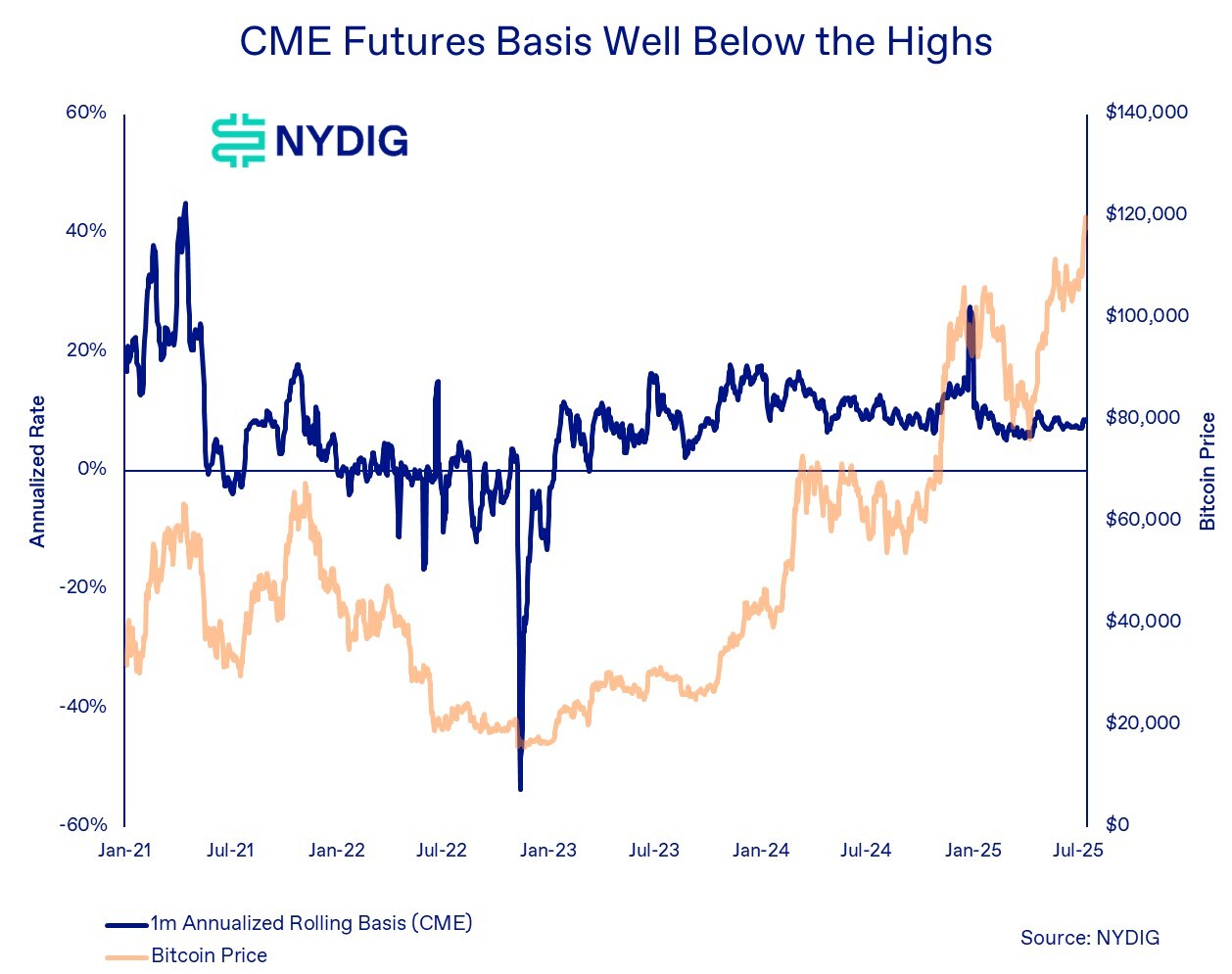
CME Futures Show Uptick in Longs as Shorts Stay Flat
CME futures contracts held by leveraged funds (hedge funds and commodity trading advisors) show little change. The longs are likely driven by price momentum strategies employed by CTAs, while the shorts are driven mostly by hedge funds employing basis arbitrage. The long positions are still below their prior peak, both in number of contracts and in notional value (5 times the number of contracts times the price of bitcoin). On the short side, with the CME futures basis still subdued (see prior section), we won’t be seeing hedge funds increasing their exposure to the basis trade until the basis expands.
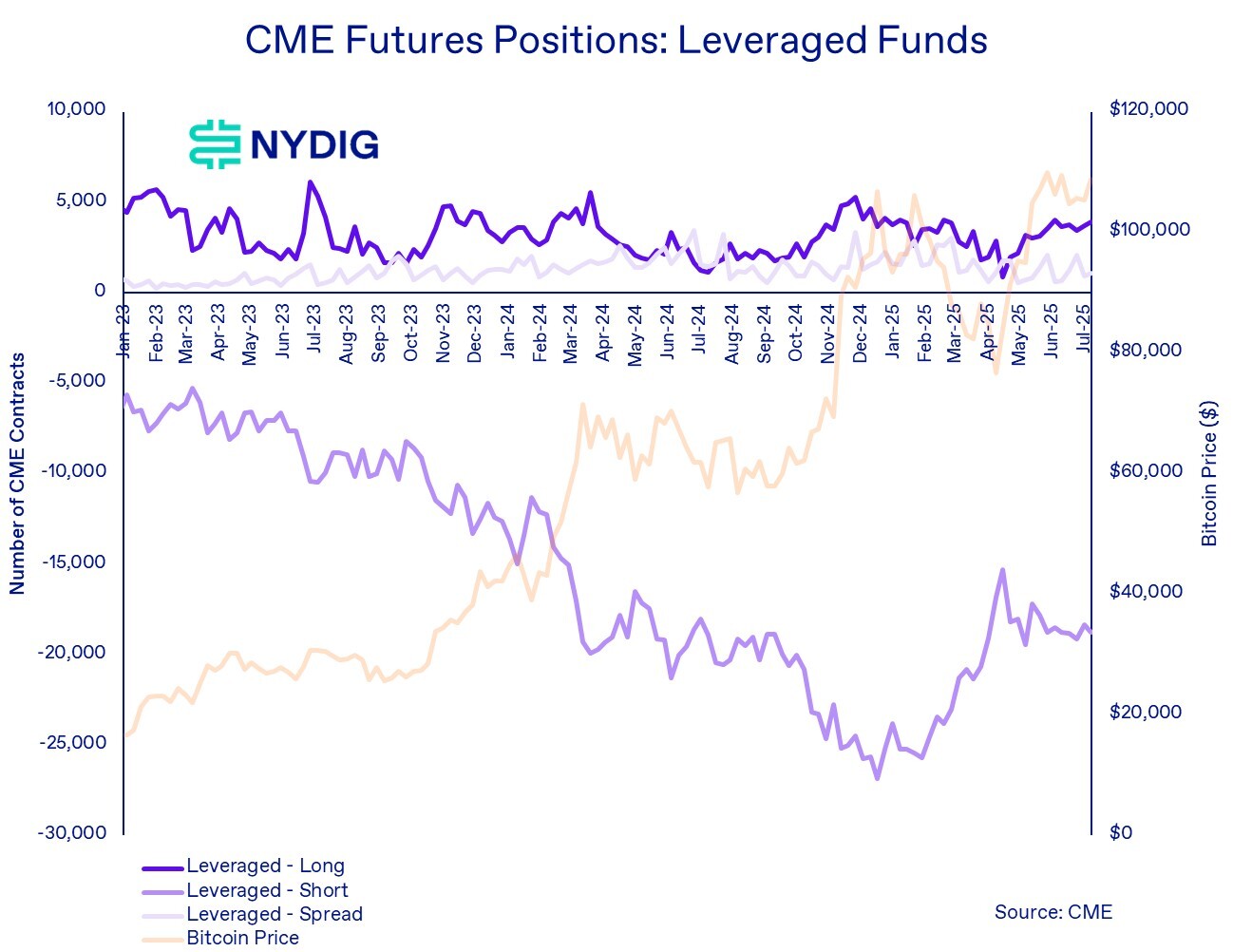
Borrow Rates on Stables
Aave, initially launched on Ethereum and now operating across multiple blockchains, is the largest lending and borrowing platform in the DeFi ecosystem. Borrowing rates for stablecoins like USDT and USDC serve as a gauge of leverage demand. Currently, these rates are hovering in the mid-single digits. However, when bitcoin reached a new all-time high in December, stablecoin borrow rates spiked above 20%, suggesting that today’s levels remain well below thresholds typically associated with market overheating.
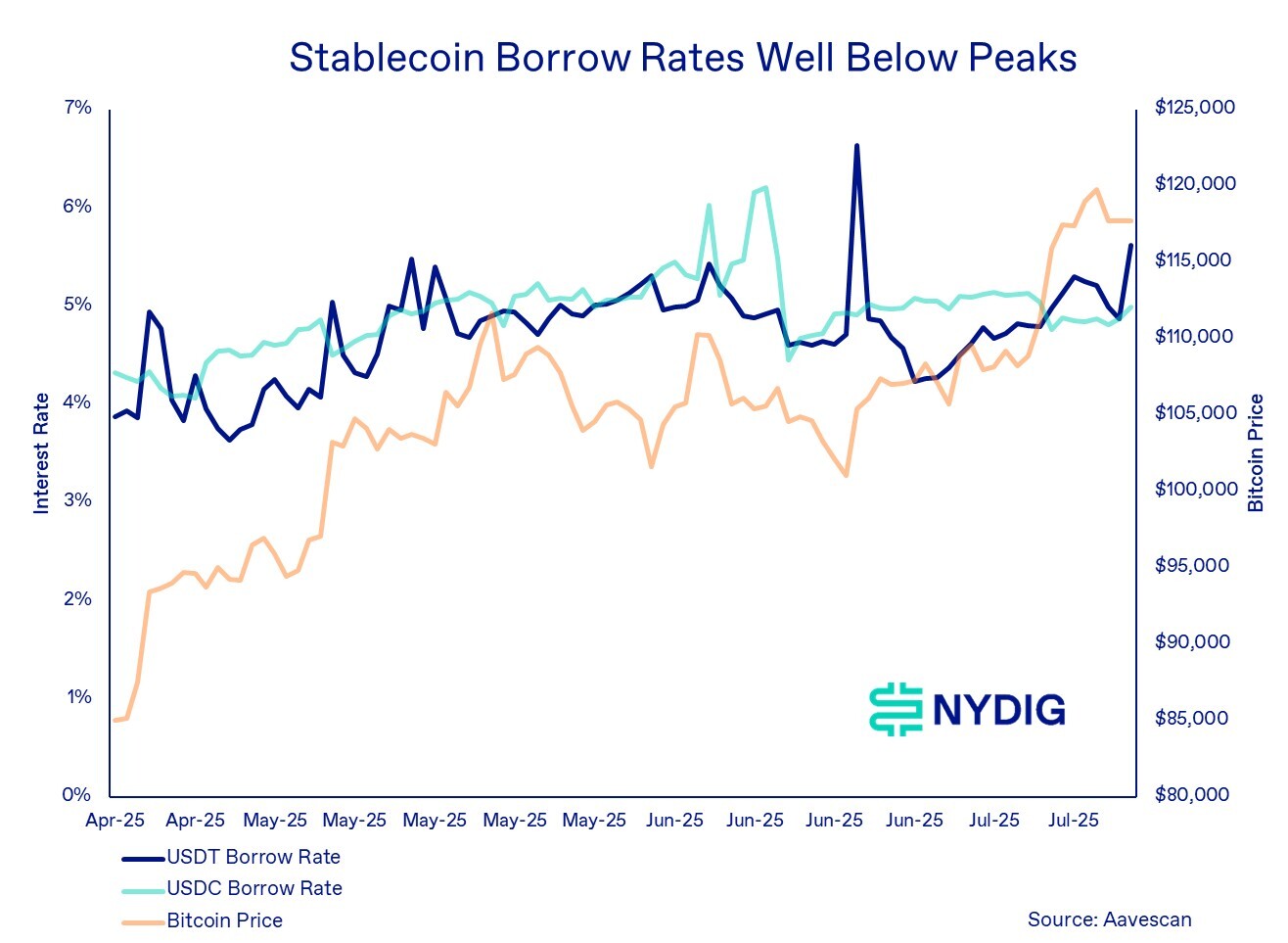
Final Thoughts
While bitcoin continues to hit new all-time highs and altcoins have now kicked into gear, many measures of market exuberance remain subdued. Trader positioning does appear to be speculatively bullish based on market metrics. We may get there if this rally continues to have legs, but at least in the short term, it does not seem to be showing signs of excessive froth.
July 4th Whale Exits Position
The “July 4th Whale” we wrote about last week continued to make moves this week, consolidating holdings, cutting his or her position in half, and possibly affecting the market price. As a refresher, beginning on July 3rd and continuing into July 4th, 80,000 BTC associated with a long-dormant holder awakened, moving coins to new addresses for the first time since 2011. The movements were preceded by several strange messages from an entity directing them to a Salomon Brothers site, as well as numbers from a repeating theme on the TV show Lost. We still think the Salomon Brothers and Lost messages are a red herring—they continue to be broadcast to large long-term positions on-chain that are not associated with the July 4th Whale.
Beginning Monday morning (July 14th), the July 4th Whale began to move bitcoins out of half of the recently created addresses. Bitcoins totaling just over 40,000 reached addresses associated with Galaxy Digital on Monday evening around 10:20 PM ET. We believe these bitcoins were sent to Galaxy and subsequently sold, with Galaxy laying off risk to other trading counterparties, such as centralized exchanges like OKX and Binance.
Then, on Thursday evening around 5:40 PM ET the July 4th Whale began to move the remaining ~40K bitcoins to Galaxy. All the long-dormant 80,000 bitcoins that began moving around July 4th have now been transferred to Galaxy, likely sold.
Judging the Whale’s Impact on Price
While it's difficult to quantify the precise impact of the whale’s activity on bitcoin’s price, the timing of the first movement aligns closely with a reversal in upward momentum. The whale’s bitcoin began moving on-chain at 9:42 AM Monday, triggering alerts from whale tracking services. Galaxy, serving as the market maker for this transaction, may have initiated short sales ahead of delivery, which began around 10:20 PM that evening. The second half of the coins began hitting Galaxy around 5:40 PM on Thursday.
Galaxy’s purchase from the July 4th Whale would then have been used to cover those short positions. It’s plausible that Galaxy executed these shorts across a mix of OTC trading desks and centralized exchanges, as platforms like OKX and Binance offer access to both, before transferring the bitcoin to close the trade.
Although it's impossible to know the full extent of the price impact, the timing of the initial movement closely aligned with a sharp market reversal. After reaching an all-time high of $123,000 on Monday afternoon, Bitcoin fell more than 6% to a low of $116,500 by Tuesday morning. In contrast, the second batch movement had a much smaller effect on price, resulting in only about a 1% decline.
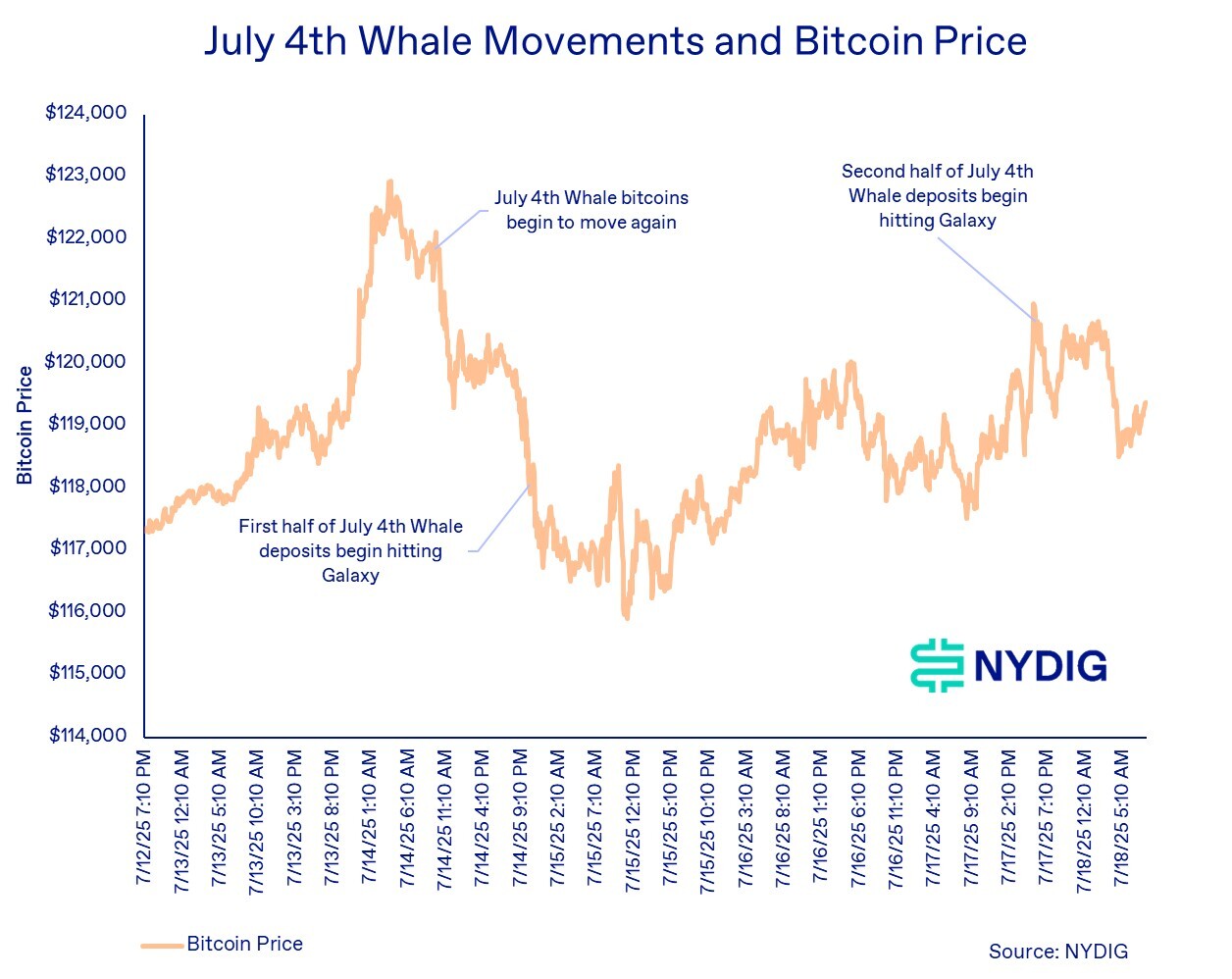
Legislation Progresses in the House’s “Crypto Week”
Congress made significant progress on crypto-related legislation this week during what the House of Representatives labeled “Crypto Week.” Lawmakers passed the GENIUS Act to regulate stablecoins, moved forward with crypto market structure reforms through the CLARITY Act, and approved the Anti‑CBDC Surveillance State Act aimed at restricting central bank digital currencies. The stablecoin bill is now on its way to the President’s desk for signature, while the market structure and anti-CBDC bills will proceed to the Senate for further debate and consideration. While not over the final finish line, this is a momentous week for crypto regulation in the US, bringing clarity that the industry has sought for a decade or more now.
In other regulatory developments this week, Nasdaq submitted a 19b-4 filing seeking approval to amend BlackRock’s iShares Ethereum ETF to permit staking of ETH within the fund. Finally, in a surprise move, the SEC announced it will review its own decision to approve the exchange listing of the Grayscale Digital Large Cap Fund (GDLC), a step that would have effectively converted the product into an ETF. Although the initial approval was granted on July 1st, the SEC has now placed the decision under review with no specified timeline for resolution. This reversal is significant as the GDLC includes XRP, SOL, and ADA alongside BTC and ETH. Its approval would have marked the first time an asset other than BTC and ETH had been allowed in a spot ETF.
Market Update
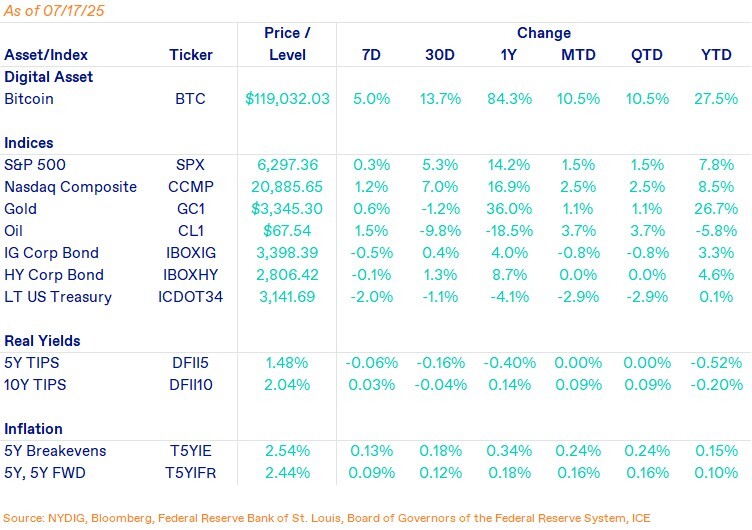
Bitcoin extended its rally this week, climbing 5.0% and setting a new all-time high of $123,231 on Coinbase on Monday. While selling pressure from the July 4th Whale temporarily cooled market momentum, strong demand from spot ETFs, corporate treasuries, and retail investors suggests this overhang could be absorbed in short order. Over the past five trading days, spot bitcoin ETFs have seen average daily inflows of $610 million, enough to offset $4 billion overhang from the most recent whale transfer in just 6.5 days at current pace.
Meanwhile, risk-on sentiment was evident across markets. Both the S&P 500 and Nasdaq Composite reached fresh record highs, while bonds declined. Gold edged up 0.6%, and oil advanced 1.5%, reflecting broader investor appetite for risk and inflation-sensitive assets.
Even as bitcoin reached new all-time highs this week, the spotlight shifted to Ethereum and other altcoins, which have surged over the past week and a half. As a result, despite bitcoin hitting new highs, its market dominance declined.
Many have asked what's driving this renewed strength in altcoins. Notably, it’s not due to any major shifts in fundamentals, utility, or real-world adoption. Instead, the rally has been largely indiscriminate, with capital flowing broadly across the altcoin landscape, although certain assets and sectors have outperformed others.
One possible catalyst is the House’s “Crypto Week”, which likely helped spark the rotation into alts. However, key legislative developments like the CLARITY Act are expected to take a couple of months to make their way through the Senate, so investors should temper their expectations for immediate regulatory impact.
Important News This Week
Investing:
Donald Trump Set to Open US Retirement Market to Crypto Investments - FT
Bhutan Moves Over $62 Million In Bitcoin to Binance in Past Four Days: Arkham - The Block
David Bailey’s Fund Is Up 640% After Converting Trump on Crypto - Bloomberg
Regulation and Politics:
FOIA Reveals US Marshals Sitting on at Least $1.6B in BTC - Protos
BTC Held by the US Marshal Service - The Rage
1 In 5 Top Trump Picks Held Crypto, Some Worth Millions, Post Finds - WaPo
Companies:
Grayscale Investments Announces Confidential Submission of Draft Registration Statement - Grayscale
Standard Chartered Says It’s the First Global Bank to Offer Spot Bitcoin and Ether Trading - CoinDesk
Digital Asset Trading Technology Firm Talos to Buy Coin Metrics for More Than $100M: Sources - CoinDesk
Bitcoin Treasury News: Semler Scientific Adds to Holdings - CoinDesk
Upcoming Events
Jul 15 - CPI release
Jul 22 - EO Working Group report deadline
Jul 25 - CME expiry
Jul 30 - FOMC interest rate decision




